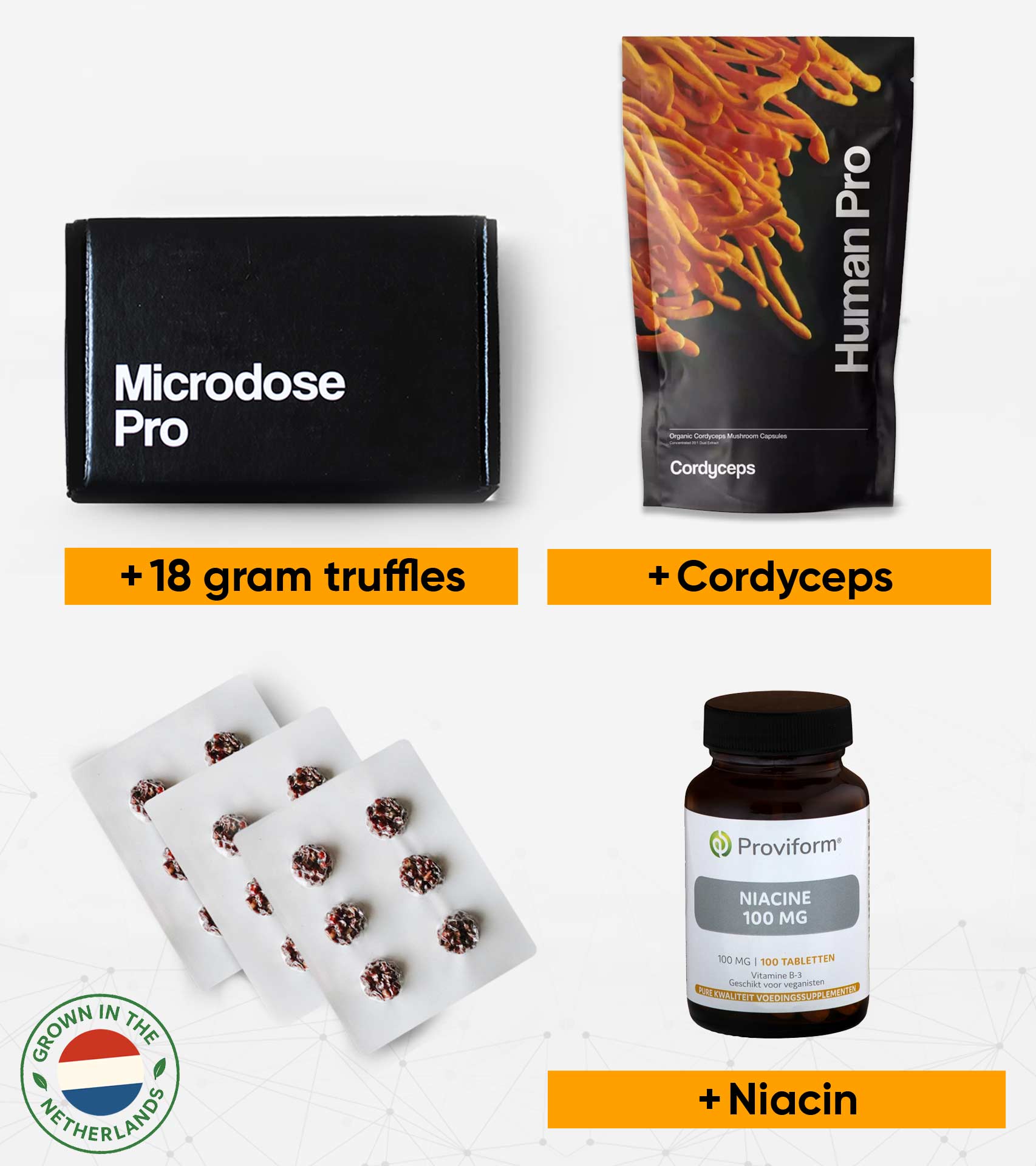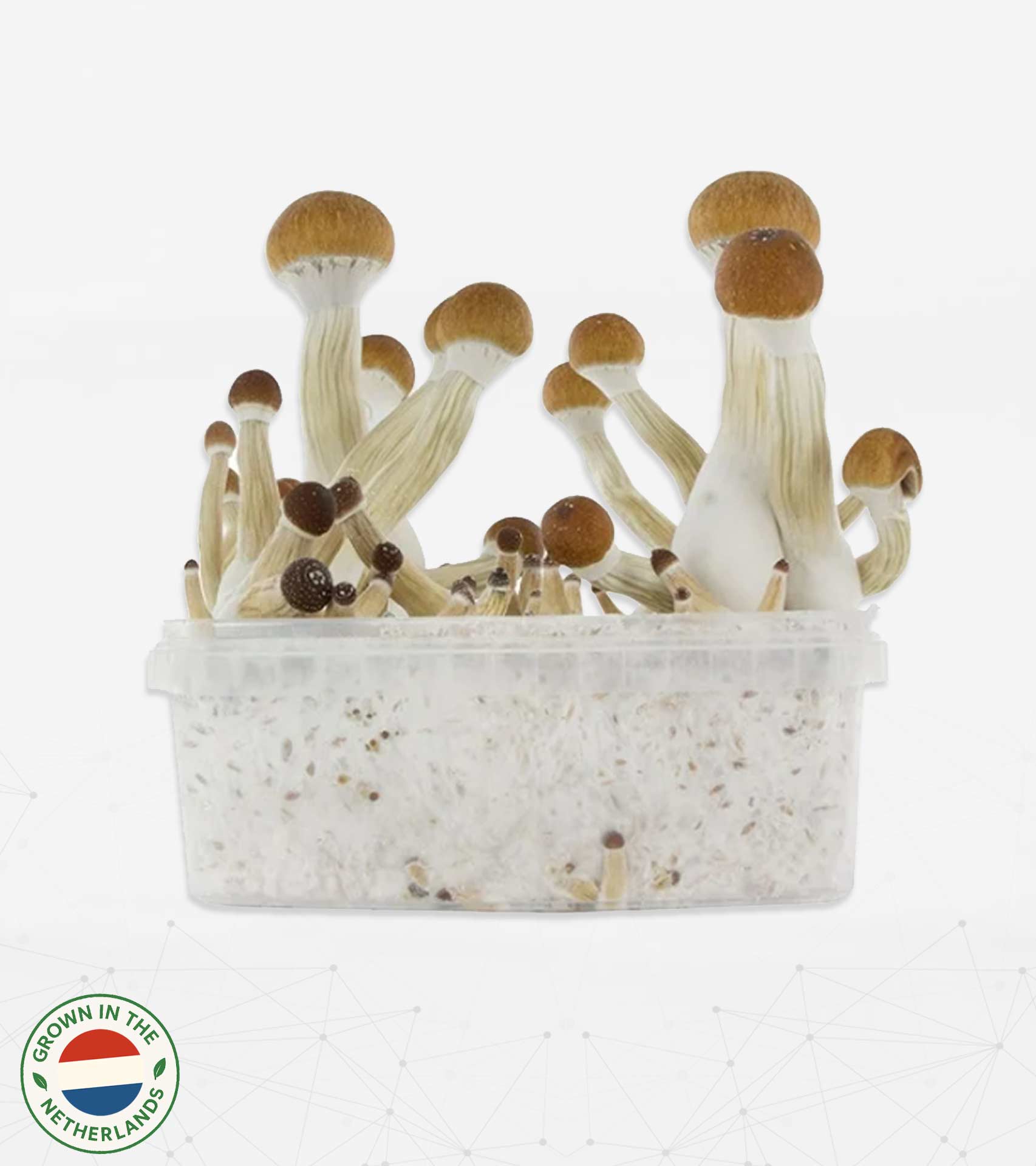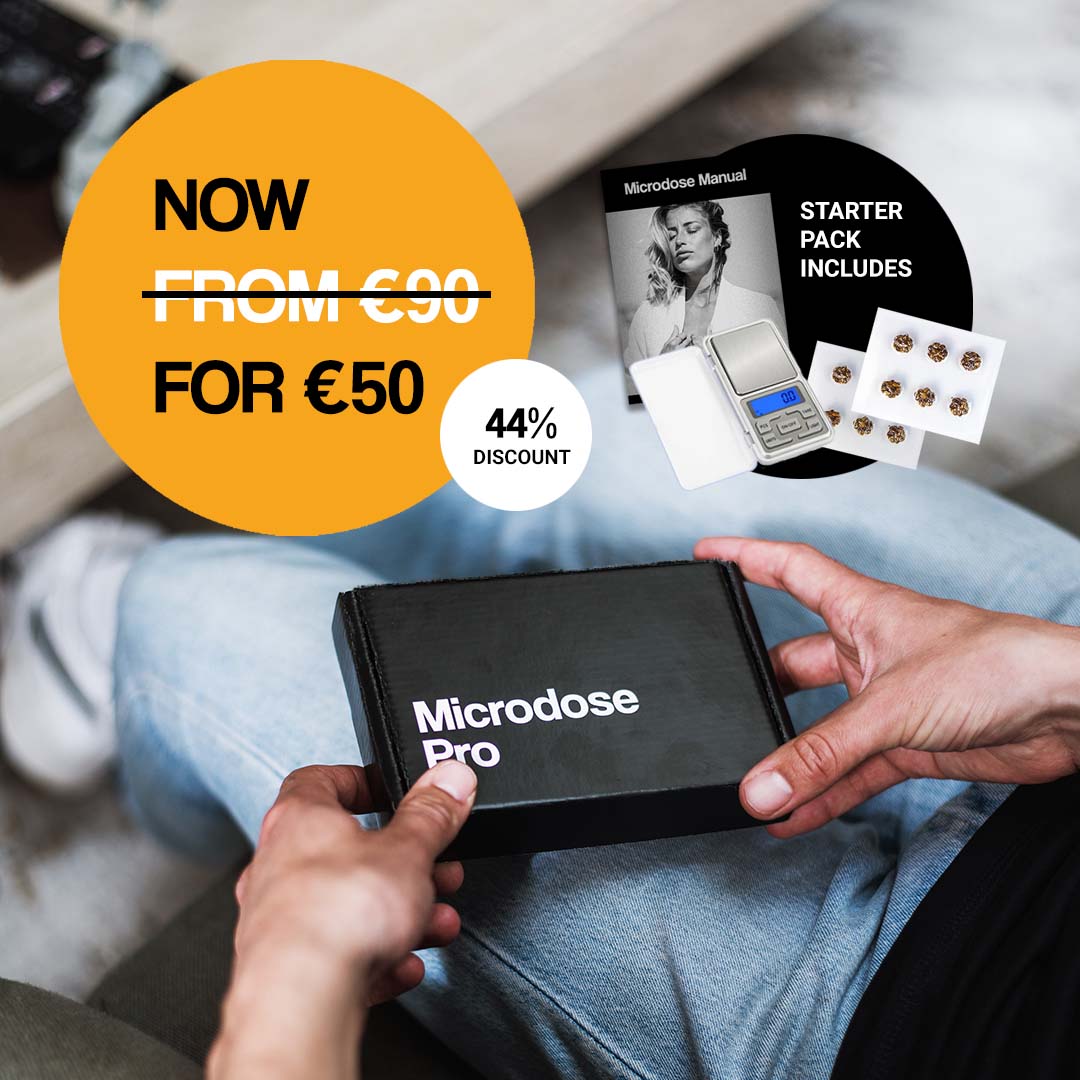Can microdosing LSD really make you smarter, happier or healthier? The Netherlands’ leading microdosing brand investigates.
Of all the web pages in the world – and there are 4,2 billion of them – you’ve landed up on this one, which means you are probably on a quest to find out about LSD, or microdosing, or the two in combination. So get ready to scroll … and scroll … because everything you need to know about taking tiny doses of LSD – also called Trips, Tripper, Tab, Stars, Smilies, Rainbows, Paper Mushrooms, Micro Dot, Lucy, Lightning Flash, Hawk, Flash, Drop, Dots, Cheer, Blotter and Acid – is right here.
What is microdosing LSD?
Microdosing is a fast-growing lifestyle trend in which people consume very small amounts (literally micro amounts) of a psychedelic substance, usually every couple of days over the course of several weeks – with the intention of improving their mood, focus, creativity, motivation or energy levels.
Microdosing involves taking such a small dosage of the psychedelic in question that the user is generally able to continue with their daily life quite capably; neither they nor anyone they interact with on the day they microdose should notice any major changes in mental behaviour. Any changes they do notice should be very subtle.
LSD – scientific name lysergic acid diethylamide – is (an illegal) synthetic street drug that people obtain in powder, liquid, tablet, or capsule form. It can also come in small pieces of absorbent “blotter” paper (blotter art is a subculture that has been thriving for decades). The widely recognized psychedelic researcher, Dr James Fadiman, measures an LSD microdose as somewhere between 8 and 15 micrograms – and recommends beginning with 10 micrograms.
Depending on what form the LSD comes in, a microdoser might deposit this small amount of LSD powder into an empty gelatin capsule and swallow the capsule, or they might mix either the powder or liquid LSD into water and ingest it that way.
What is the history of LSD?
Unlike the use of naturally occurring psychedelics like certain types of mushrooms, mescaline, or iboga, which can be traced back to ancient times, the origins of LSD can be definitely traced to 1938 and the research work of Swiss scientist Albert Hoffmann. Hoffmann developed lysergic acid diethylamide by working with a chemical found in ergot, a fungus found growing on rye and other grains. His intention was to develop a respiratory and circulatory stimulant, or analeptic, for medical purposes. However, he set this work aside for a while and it would be another five years before he returned to it –
and accidentally ingested a small amount of the new substance he had created. Hoffmann entered into a heightened sensory experience – “At home, I lay down and sank into a not unpleasant intoxicated like condition, characterized by an extremely stimulated imagination. In a dreamlike state, with eyes closed (I found the daylight to be unpleasantly glaring), I perceived an uninterrupted stream of fantastic pictures, extraordinary shapes with intense, kaleidoscopic play of colors. After about two hours this condition faded away.”
A few days later, Hoffmann intentionally ingested more LSD, to confirm its psychedelic effects. Within his wider work, he went on to research its properties for decades, eventually dying at the age of 102, in 2008. Until his death, Hoffmann believed that “scientists and psychiatrists should be allowed to investigate LSD’s effects and prescribe it in a safe, controlled fashion”- on the flip side, he also acknowledged LSD’s potency and dangers, and decried the seedy reputation it had garnered due to widespread misuse.
The 1960s: Legal LSD’s swansong
By the mid-20th century LSD – “acid” – was gaining widespread traction in artistic circles with authors, actors, musicians and a host of members of the US counter-culture using it as a way to tune out from reality or to stretch the limits of their thinking. Academics like Timothy Leary were researching the mind-expanding capabilities of LSD and becoming vocal proponents of psychedelics.
Meanwhile, the CIA was investigating the potential of LSD and other substances to be used as a psychological weapon in the Cold War. Ultimately, the USA government came to view LSD as more of a growing danger than a potential benefit to society and banned ownership of LSD in 1968. LSD had already been banned in the UK in 1966. By 1970 it was pretty much banned everywhere – even as its potentially beneficial capabilities within psychiatric treatment, ironically, were becoming very compelling to a number of researchers.
The era of hyper creativity
Of course, the new illegal status would not stop the “hippie” culture from continuing its interactions with LSD/acid throughout the 1970s, despite frequent brush-ins with the law. In the 1980s its use filtered into the punk and gothic subcultures and, in the 1990s, a massive acid movement mushroomed out of the music scene in Manchester, England. The phenomenon was coined “Madchester” and acid use centered largely around “raves” (rave culture would go on to grow into festivals on the massive scale of Tomorrowland).
Perhaps out of all the psychedelics, it is LSD that has most found its way into almost every stream of pop culture. There are a number of songs allegedly inspired by acid trips, including Jefferson Airplane’s White Rabbit and I am the walrus by The Beatles. A number of classic books are themed around LSD including The Doors of Perception & Heaven and Hell
by Aldous Huxley and, most famously, Hunter S. Thompson’s Fear and Loathing in Las Vegas – later adapted into an eye-watering film (trailer here, if you’ve never seen it).
LSD has had numerous outings as a cinematic star, in films like 1967’s The Trip and the 2002 documentary Gambling, gods and LSD. Meanwhile it would be almost a half-century after its USA-led banning that the potential psychiatric benefits of LSD would once again become quite seriously investigated, within the rise of a new sub-culture: microdosing.
LSD makes a (very small) comeback
In November 2015, a widely-read article in Rolling Stone magazine reported on the phenomenon of young professionals, particularly in the San Francisco/Silicon Valley area, using “microdoses” (around 10 micrograms) of LSD, not to go on wildly erratic trips but simply to become better at solving technical problems and to stimulate innovative thinking.
It was around this time that the practice of microdosing various substances, including LSD, became an increasingly common topic of conversation everywhere from Reddit and Twitter to the laboratories of renowned universities. Microdosing had been gaining ground as a trend for several years prior to the Rolling Stone piece and other editorial coverage, around the microdosing studies of James Fadiman and his 2011 book The Psychedelic Explorer’s Guide but, between 2015 and 2020, it really entered into the public domain noticeably.
What are the benefits of microdosing LSD?
Taking too much LSD can result in terrifying hallucinations and disorientation, but a person cannot technically take so much LSD that it kills them (this is where psychedelics differ from things like heroin, Xanax – even alcohol; there is no known lethal dose of LSD, even in the case of a woman who accidentally took 550 times the amount of a “normal” LSD dose).
That said, a person might experience such a “bad trip” from too much LSD that they self-harm in some way in the midst of it, for instance believing they can fly from a tenth-floor window ledge. The danger with too much LSD is not so much what it would do to you, but what you might do to yourself.
However, when it comes to microdosing LSD, a person would be ingesting such a small amount of it that any noticeable effects should be minor and, hopefully, all positive. According to Rico Doblin, executive director of psychedelic research nonprofit MAPS, with microdosing “your cognitive processing is slightly enhanced in certain ways – more creative, more focused, a little bit of a mood elevation – but you’re not in any way tripping. And you can drive. You can do all sorts of things that you wouldn’t do if the dose were higher”.
Microdosing has its share of sceptics, most especially in the medical and scientific fraternities. David. E. Nichols, an adjunct professor of chemical biology and medicinal chemistry at the University of North Carolina, USA: “There is absolutely no credible research on microdosing as of today.” For many medical doctors, the wealth of personal accounts about microdosing online clearly hold little weight, no matter how detailed they might be (doctors usually prefer to tell patients what different things do to them, not the other way around). Yet because there isn’t yet a lot of hard science around the practice of microdosing, information of its benefits or effects must come largely out of the personal accounts of microdosers (James Fadiman has collected hundreds of these, apparently). Here are a few we have found online:
“I know what I need to do and I’m not distracted. I had significantly fewer impulses to jump over to Facebook, texting, or email, and was more content to go for a long period focusing on one thing without additional stimulation.” – Nat Eliason
“The microdosing lessened the force of the riptide of negative emotions that so often sweeps me away, and made room in my mind not necessarily for joy, but insight” – Ayelet Waldman
“It interrupts your regularly scheduled programming. Default networks of the brain quiet down, making way for new channels and connections. So previously segregated regions of the brain begin communicating. Like upgraded lighting to dim fluorescents and brighten shadows in your mind. Illuminating corridors and doors you never knew existed.” – Erica Avey
“Basically, every day turns out to be a good day. At work, you feel ready for anything and even enjoy doing everyday tasks.”- “John” (name changed)
“The effect is subtle. After an hour, colors seem richer, edges more defined. Sunlight assumes a different quality, flickering softly at the edge of my peripheral vision. It’s like looking at the world in HD after a lifetime in low resolution. I feel calm and present. Optimistic, even. Small stressors are easier to shake off. At dinner that night I feel personable… “ – Dan Dalton
“It’s basically like taking a cup of coffee …You’re just able to be a little more free and a little more honest with your emotions without breaking down. There’s more of a mental clarity.”- Marc Morgan
That all sounds pretty good but, on the flip side, some recent research has surmised that microdosing LSD doesn’t really do much at all – “despite all the anecdotal evidence, the first double-blind, placebo-controlled study on LSD microdosing finds that taking tiny amounts of acid doesn’t do much more than get you just a little bit high.” – Dan Dalton
Let’s search a little deeper for potential benefits …
While it appears that the effects of microdosing LSD are subtle and fairly subjective when it comes to mental aspects like heightened mood, focus, and creativity – the evidence is thin – when it comes to LSD’s potential for pain reduction therapy, the data is more compelling. A recent study by researchers from Maastricht University and the Beckley Foundation focused on non-hallucinogenic, low doses of LSD for pain management. The results, from an ingested amount of LSD 20 µg, were “significantly increased pain tolerance by about 20%, and decreased subjective levels of experienced painfulness and unpleasantness.”
From the same study, “The findings point toward long-term pain relief that kicked in within 90 minutes of administration of the microdose and that persisted for at least five hours afterward.”
Meanwhile, biomedical startup Eleusis is investigating the anti-inflammatory potential of sub-perceptual doses of LSD in halting the progression of Alzheimer’s disease in its early stages. As CEO Shlomi Raz related to Abbie Rosner on Forbes, “When I put together the entire picture of what psychedelics were doing, it became quite clear that this could be a therapy to modify the course of Alzheimer’s disease.
LSD in particular seemed like an attractive candidate … as it is capable of potent and prolonged activation of the serotonin and dopamine neurotransmission receptors implicated in Alzheimer’s disease, and specifically the serotonin 2A receptor.”
There is a growing amount of research going on around the potential for LSD to treat things like depression, post-traumatic stress disorder, drug dependency, and acute anxiety in patients with life-threatening diseases. As the ADF reports here, how LSD may be effective in improving aspects of mental health seems to be linked to it “helping individuals see the ‘bigger picture’ beyond their personal problems.”
In assessing a cross-section of resources on the web it seems clear that the general opinion is that a lot more research needs to be done into the potential positive benefits of LSD, whether ingested in microdoses or possibly prescribed medically (should the law ever allow that), before definitive conclusions can be drawn. When microdosing LSD according to a generally accepted protocol, like that of James Fadiman, the effects of LSD – positive or otherwise – are likely to be fairly mild for most people.
What are the risks of microdosing LSD?
Undoubtedly, the biggest risk with microdosing LSD is getting it in the first place. LSD is illegal in most countries around the world.
Here, The Third Wave lists LSD’s legal status in the following countries: Ecuador: legal to possess up to 0.0020mg of LSD; Czech Republic: possessing up to 5 blotters of LSD is considered a “misdemeanor” and carries a relatively low monetary fine; Portugal: not legal but low enforcement of that status. Mexico: possession of up 0.015mg is allowed but not on the grounds of public institutions like schools and prisons; USA – classified as a Schedule I controlled substance; Canada – classified as a Schedule III controlled substance; Australia -prohibited substance; United Kingdom – classified as a Schedule 1 Class ‘A’ drug; rest of the world: Illegal, according to the 1971 UN convention on psychotropic Substances.
What about the Netherlands? LSD, along with other “hard” drugs, is classed as illegal (unlike cannabis and psychedelic or psilocybin truffles). This is a detailed Wikipedia overview of drug policy in the Netherlands. At Microdose Pro we advocate the responsible use of psilocybin-containing truffles for microdosing, where it is within the law and for people aged 18 or older. Although we’re very interested in LSD as a research subject, we do not advocate the microdosing of LSD.
Psychological or physiological risks
Many doctors point out the potential risks of microdosing psychedelics, including LSD. While it is not considered addictive like cocaine or heroin – alcohol even – microdosers could develop a tolerance that makes them take increasingly larger doses to get the same effect. Doing so may arguably lead to or aggravate long-lasting psychoses like schizophrenia or depression.
We also discussed earlier in this piece how taking too much LSD could lead to a “bad trip” during which a person might self-harm themselves, whether intentionally or accidentally. Even if they don’t, a bad trip can be terrifying and debilitating. According to American Addiction Centres in 2011 alone, there were about 5 000 visits to emergency departments in the United States relating to adverse reactions to LSD. We’re still talking here about high or excessive amounts of LSD though; if you were microdosing strictly to the advised amounts and to a set protocol, or schedule, would there still be risks?
There is not much research to draw on, yet it does seem that any potential pitfalls lie in microdosers not sticking to a set small microdose and upping their dosage after a while and/or becoming mentally dependent on microdosing as a long-term panacea. Erica Avey:
“James Fadiman, a.k.a. “the Father of Microdosing” and creator of the most widely used microdosing protocol – one day on, two days off, for a month – advises that afterwards, people dose as they wish. And that’s where things got tricky for me.” Later she writes:
“In the summer of 2019, after two years of dosing, my final few microdoses shot me into extreme anxiety and unease. I haven’t microdosed since. It could be that I needed to lower my usual 15 microgram dose.”
While LSD is not physically addictive, Oxford Treatment Centre advises that microdosing it “fails to address potential risks with consistently taking a potent drug, including the feeling that one’s stability or wellbeing rely on consuming the substance, or chronic side effects like flashbacks or psychosis … too much of this drug can induce psychosis, making mood disorders worse and potentially triggering schizophrenia or psychotic disorders in those prone to these conditions.”
Again, it appears that the risk mainly lies in taking too much LSD or taking it for too long a period. The best practice, for those who choose to microdose LSD, would appear to be sticking to the same low dose, for example, 6 – 10 micrograms, following a protocol like Fadiman’s and stopping the microdosing after a set period. This is what we have gleaned from our research – but we would welcome both personal and medical input on the potential risks (and benefits) of microdosing LSD and would gladly incorporate any feedback into this piece.
How do you microdose with LSD?
Before you microdose any psychedelic for the first time, we advise you ensure three things in order to make it a positive experience:
- That you are free from work, social engagements, or any other commitments for the day.
- That you have a peaceful environment to microdose in, where you won’t be disturbed.
- That your state of mind is calm – you aren’t feeling stressed or anxious.
In order to microdose LSD, you would of course need the substance itself. Because microdosing deals in such small amounts – one-tenth of a “normal” LSD dose – it would be best to have the LSD in a powder form (measuring out one-tenth of a blotter paper would not be very accurate). You would need a sensitive scale, able to measure out microgram-level amounts of substances.
If you have the LSD in tablet form you would need a small grinder, like a coffee grinder, to turn it into powder; you could also use a mortar and pestle. The LSD powder can be mixed into a drink, such as a smoothie, and ingested that way. Many microdosers empty the powder into empty gelatine capsules, which are widely available, and swallow the capsules.
Optimising your microdosing experience
Microdosing journaling is the habit of logging your daily experience of microdosing. There are two reasons why doing so is important:
- Journaling your experience will help you track the effects of microdosing and to work out, should you experience any negative effects, whether you need to dial back the frequency or amount of your microdoses.
- Microdosing is a journey of discovery – and journaling and sharing your experience of microdosing will add to the store of knowledge on this lifestyle trend. Your journal could in the future be a helpful resource for those new to microdosing.
Where can you get LSD for microdosing?
We are most pleased, at this juncture, to redirect you to our online shop, where you can consider ordering microdosing kits containing psilocybin (“magic”) truffles which, if you’re reading this in the Netherlands, are legal. You’ll also get 20% off the normal price by using the code HYPERFLOW. Read more about microdosing truffles here.
However, given their illegal status in much of the world, we are unable to offer advice on where to obtain LSD, or other illegal psychedelics, for microdosing.
We thank you for reading this article and please get in touch with us about any queries you have – we are here to help. If you’d like more of a macro-view on microdosing, beyond just LSD, have a look at this companion article.
Primary sources:
https://medium.com/better-humans/how-one-year-of-microdosing-helped-my-career-relationships-and-happiness-715dbccdfae4
https://www.psytech.biz/the-netherlands-is-psychedelic-friendly/
https://qz.com/1036444/lsd-in-microdoses-can-make-you-a-better-manager-says-paul-austin-of-the-third-wave/
https://www.iflscience.com/health-and-medicine/psychedelic-drugs-can-help-alcoholics-stop-drinking-according-new-study/
https://www.theverge.com/2017/4/24/15403644/microdosing-lsd-acid-productivity-benefits-brain-studies
https://medium.com/@rossstevenson/the-benefits-of-micro-dosing-my-workouts-c9ea958fb49
https://www.medscape.com/viewarticle/924368
https://www.thecut.com/2018/05/microdosing-guide-and-explainer.html
https://www.wweek.com/culture/2017/04/18/i-tried-microdosing-with-four-different-psychedelic-drugs-heres-what-happened/
https://doubleblindmag.com/brief-history-of-lsd-holiday-bicycle-day/https://www.wired.com/story/a-microguide-to-microdosing-psychedelic-drugs/
https://sites.google.com/view/microdosingpsychedelics/home
https://www.healthline.com/health/beginners-guide-to-microdosing#The-negative-side-of-microdosing
https://www.addictioncenter.com/drugs/hallucinogens/lsd-addiction/microdosing-lsd/
https://en.wikipedia.org/wiki/Drug_policy_of_the_Netherlands
https://thethirdwave.co/microdosing
https://en.wikipedia.org/wiki/Microdosing
https://harmreductionjournal.biomedcentral.com/articles




